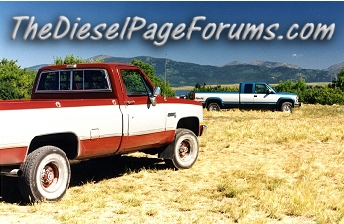

Originally Posted by
DmaxMaverick

To repeat what I've said before.....
In my educated opinion, this is not good advice. Add a lift pump pre-filter if you wish, but do not remove the sock as a course of corrective or preventive action. If your sock is plugging, or giving you ANY grief, you have a SERIOUS fuel quality problem. The sock is nothing more than a relatively coarse screen, which will catch metal flakes, pebbles, sand, algae or other large debris that may plug the pickup tube inlet. If your sock is plugging up, you would have had to replace dozens of filters by this time. If the sock is plugged, the tank and entire fuel system needs to be cleaned and flushed. It's that simple. I hear the sock getting blamed as a "problem", while it almost never can be. Of course it can fail, but it will never cause the problems it is blamed for. It will almost always be the result of a problem, and almost never be the cause of one.
I agree with DMAX, don't leave the sock off. However, as I have found out first hand, the aftermarket socks are NOT the same quality as the OEM versions. If I were in your boat, I would spend the money for a genuine GM sending unit with new sock.
The plastic sock that came on my aftermarket unit was shot to crap after 15K miles. I reinstalled my old 200K mile OEM sock, and all has been well since!  I am currently at 254K miles. I chased my problems round and round, and it was the stupid, cheap, plastic sock that was restricting flow.
I am currently at 254K miles. I chased my problems round and round, and it was the stupid, cheap, plastic sock that was restricting flow.
I don't think the plastic crap used on the aftermarket sending units is compatible with diesel fuel, especially biodiesel and bio blends. All the little holes in the sock swelled shut and wouldn't let fuel flow through. The OEM sock is not made of plastic, but some other durable material.
I know it wasn't a fuel quality problem, because I chased this problem for months over multiple tanks of fuel. After swapping socks, the problem went away, even though I am still using the same sources of fuel. Also, I tried cleaning the "new" sock with brake cleaner and other solvents, and I could not get it to flow properly. It was definitely a poor quality product.
Again, here is a photo showing the two socks and the different constructions of each.... aftermarket on left, OEM on right:

Notice the relief valve on the OEM version.... not even present on the aftermarket unit. The aftermarket version also has a plastic screen inside the outer screen, so it is three layers thick. Very difficult for diesel to flow through.
Casey
1995 K1500 Tahoe 2 door, 6.5LTD, 4L80E, NP241, 14 Bolt SF rear, 3.73's, 285/75R16 BFG K02's; 1997 506 block; Kennedy OPS harness, gauges, Quick Heat plugs, and TD-Max chip; Dtech FSD on FSD Cooler; vacuum pump deleted, HX35 turbo, Turbo Master, 4" Quadstar exhaust, F code intake; dual t/stats, HO water pump, Quadstar radiator and cooling fan/clutch combo; Racor fuel filter












 I am currently at 254K miles. I chased my problems round and round, and it was the stupid, cheap, plastic sock that was restricting flow.
I am currently at 254K miles. I chased my problems round and round, and it was the stupid, cheap, plastic sock that was restricting flow.







